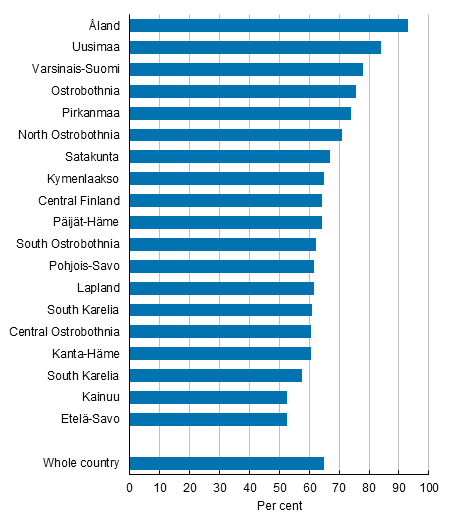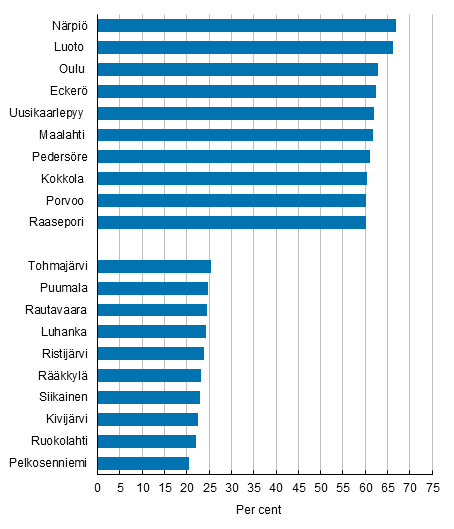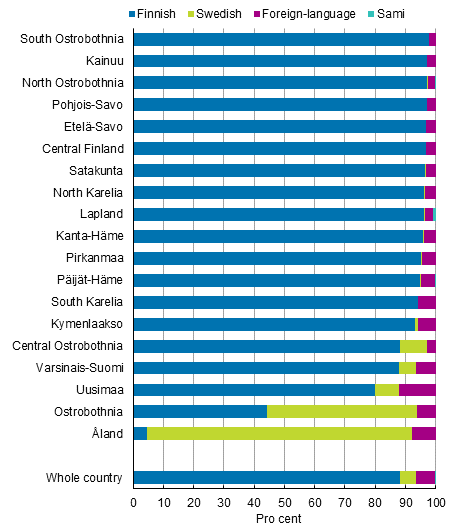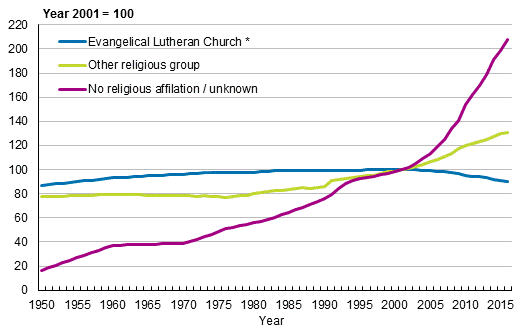Published: 22 September 2017
Two-thirds of Finns live in their region of birth
According to Statistics Finland's statistics on population structure, two-thirds of persons residing permanently in Finland lived in their region of birth at the end of 2016. Of persons residing permanently in Finland who had been born in Åland 93 per cent lived in Åland. Of the persons who had been born in the region of Uusimaa, 84 per cent lived in Uusimaa. Of the persons who had been born in the regions of Etelä-Savo and Kainuu, only around one in two lived in their region of birth.
Share of persons living in their region of birth by region on 31 December 2016

Uusimaa has gained inhabitants from those born elsewhere in Finland
At the end of 2016, the population of the region of Uusimaa was good 1.6 million persons. Of the present inhabitants of Uusimaa, 928,000 had been born in the region of Uusimaa. Of the population of Uusimaa, 527,000 had been born elsewhere in Finland and 183,000 abroad.
The population included 212,000 persons born in the region of North Karelia. Of them, 39,000 or nearly every fifth lived in the region of Uusimaa. Good 17 per cent of those born in the regions of Etelä-Savo, Kanta-Häme and Kymenlaakso were living in Uusimaa.
Share of persons living in their municipality of birth was highest in the municipalities of Närpiö and Luoto
Forty-eight per cent of persons born in Finland and living in Finland at the end of 2016 were living in their municipality of birth, when municipal mergers that have taken place over time are taken into account. Good 50,000 persons had been born in areas that were ceded to the former Soviet Union after World War II and nearly 358,000 persons had been born abroad.
Around two-thirds of the persons born in the municipalities of Närpiö and Luoto still belonging to the population continue to live in their municipality of birth. Only around one-fifth of the persons born in Pelkosenniemi who still belong to the population live in Pelkosenniemi.
At the end of 2016, there were 208 municipalities in Finland where the number of persons born in the municipalities was higher in the population than the number of inhabitants in the municipalities concerned. For example, the number of persons born in Pelkosenniemi was 2,244 at the end of 2016 and the population of Pelkosenniemi was 951 persons at the end of 2016.
Share of persons living in their municipality of birth in certain municipalities on 31 December 2016

Share of persons speaking Swedish as their native language higher than that of foreign-language speakers in three regions
At the end of 2016, Finland's population included close on 4.86 million persons speaking Finnish as their native language. The number of persons speaking Swedish as their native language was nearly 290,000, that of persons with a foreign language as their native language was almost 354,000 and that of persons with Sami as their native language close on 2,000 persons.
Examined by region, the share of Finnish-speaking population was highest in South Ostrobothnia, where the share of Finnish speakers was 97.7 per cent of the region’s population. The share of those speaking Swedish as their native language was highest in the region of Åland, 87.6 per cent, and in Ostrobothnia, 49.6 per cent. The share of persons speaking Swedish as their native language was 9.0 per cent in Central Ostrobothnia.
Population by native language by region on 31 December 2016

The share of foreign-language speakers was highest in Uusimaa, 12.0 per cent. The share of foreign-language speakers was second highest in Åland, 7.7 per cent, and third highest in Varsinais-Suomi, 6.4 per cent. The share of foreign-language speakers was lowest in South Ostrobothnia, 2.0 per cent.
Number of members of the Evangelical Lutheran Church of Finland fell below the four million mark
The number of members of the Evangelical Lutheran Church of Finland fell below the four million mark at the end of 2016. The number of members among people living in Finland has last been under four million in the 1950s. The number of members of the Evangelical Lutheran Church was at its highest in 2001, when there were good 4.4 million church members resident in Finland. During the past 15 years, the number of members has fallen by nearly 450,000 persons, or by 10 per cent.
The number of persons belonging to other religious communities was 148,000 at the end of 2016. Of them, the Finnish Orthodox Church was the biggest group.
Population by religious community in 1950 to 2016

*) May also include other Lutheran communities in 1950 to 1979. The time series is not fully comparable.
Of foreign-language speakers, 85 per cent are not members of a religious community
At the end of 2016, nearly 1.4 million Finnish residents were not members of any religious community registered in Finland. Nearly 1.1 million of them spoke national languages as their native language and 300,000 were foreign-language speakers. The number of persons with no religious affiliation has doubled in the past 15 years.
Every fifth person speaking Finnish as his or her native language and every sixth person speaking Swedish as his or her native language were not members of any religious community registered in Finland. As many as 85 per cent of foreign-language speakers are not members of any religious community registered in Finland.
Source: Population Structure 2016, Statistics Finland
Inquiries: Markus Rapo 029 551 3238, vaesto.tilasto@stat.fi
Director in charge: Jari Tarkoma
Publication in pdf-format (379.7 kB)
- Tables
-
Tables in databases
Pick the data you need into tables, view the data as graphs, or download the data for your use.
Appendix tables
- Appendix table 1. Married women by duration and order of marriage 31.12.2016 (22.9.2017)
- Appendix table 2. Females aged 15 - 81 by number of live-born children 31.12.2016 (22.9.2017)
- Appendix table 3. Males aged 15 - 81 by number of live-born children 31.12.2016 (22.9.2017)
- Appendix table 4. Women by age, number of children and the proportion of birth 31.12.2016 (22.9.2017)
- Appendix table 5. Males by age and number of children 31.12.2016 (22.9.2017)
- Figures
- Quality descriptions
-
- Quality description: Population structure 2016 (22.9.2017)
Updated 22.09.2017
Official Statistics of Finland (OSF):
Population structure [e-publication].
ISSN=1797-5395. annual review 2016. Helsinki: Statistics Finland [referred: 21.12.2025].
Access method: http://stat.fi/til/vaerak/2016/01/vaerak_2016_01_2017-09-22_tie_001_en.html

